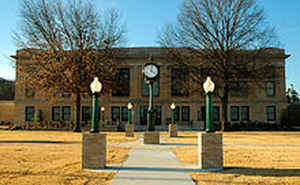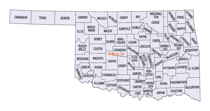Oklahoma Counties
There are seventy-seven counties in Oklahoma. Oklahoma originally had seven counties when it was first organized as the Oklahoma Territory. These counties were designated numerically, first through seventh. New counties added after this were designated by letters of the alphabet. The first seven counties were later renamed. The Oklahoma Constitutional Convention named all of the counties that were formed when Oklahoma entered statehood in 1907. Only two counties have been formed since thenLe Flore County, Oklahoma
Le Flore County Education, Geography, and History

Le Flore County is a county located along the eastern border of the state of Oklahoma. Based on the 2010 census, the population was 50,384.
Its county seat is Poteau. The name honors a Choctaw family named LeFlore.
Le Flore County is part of the Fort Smith, AR-OK Metropolitan Statistical Area.
Etymology - Origin of Le Flore County Name
Named for a Choctaw Indian family of French descent, a number of the members of which have been prominent in the tribal history.
Demographics:
County QuickFacts: CensusBureau Quick Facts
Le Flore County History
The Choctaw Nation signed the Treaty of Doak's Stand in 1820, ceding part of their ancestral home in the
Southeastern U. S. and receiving a large tract in Indian Territory. They signed the Treaty of Dancing Rabbit Creek in 1830, which ceded the
remainder of their original land and caused the removal of all Choctaws who had not voluntarily migrated to the tribe's new territory.
In 1832, the Federal Government constructed the Choctaw Agency in Indian Territory about 15 miles (24 km) west of Fort Smith, Arkansas. The
town of Skullyville grew up around the agency. The town housed Indian agents and was a stage stop (Walker's Station) for the Butterfield
Overland Mail route. It was also the Choctaw capitol for a time. In 1834, the U. S. Army built Fort Coffee a few miles north of Skullyville,
but closed it in 1838. The idled fort then became the Fort Coffee Academy for Boys, operated by the Methodist Episcopal Church. That church
also opened the New Hope Seminary for Girls in 1845, just east of town. In 1847, the Choctaw Agency burned and its functions were transferred
to Fort Washita.
The Battle of Devil's Backbone was fought near the present town of Pocola on September 1, 1863. Union Major General James G. Blunt defeated
Confederate Brigadier General William Cabell. Union troops burned the academy in 1863, because it was being used to house Confederate troops.
In 1866, the Choctaw government was able to reopen area schools. New Hope Seminary operated until it burned in 1896. The first school for
Choctaw freedmen opened at Boggy Depot. In 1892, the Tushkalusa (black warriors) Freedmen Boarding school opened three miles southeast of
Talihina.
Prior to statehood, the area that became LeFlore County was part of Moshulatubbee and the Apukshunnubbee districts, and in Sugar Loaf, Skullyville, and Wade counties in the Choctaw Nation.
Oklahoma History Center
Abutting Arkansas in southeastern Oklahoma, Le Flore County encompasses 1,608.03 square miles of total land and water
area. Sequoyah County borders it on the north, Haskell, Latimer, and Pushmataha counties on the west, and McCurtain
County on the south. The name honors the prominent Le Flore family of the Choctaw Nation. Poteau stands as the county
seat.
The physical environment varies, but is mountainous, with the Ouachita Mountains extending into the county from the
south. Associated mountain ranges, including the Winding Stair Mountains and the Kiamichi Mountains, dominate the
county's southern half, while peaks such as Sugar Loaf and Cavanal mountains stand more independently in the north.
Covered with forests, including pine and cedar, the region has fed a prosperous lumber industry. The Ouachita National
Forest covers much of the southern part of the county. The Arkansas River forms the county's northern boundary, and its
tributaries, the Poteau and the James Fork rivers, drain most of the county, with the Kiamichi, Little, and Mountain
Fork rivers in the southern portion draining into the Red River....LE
FLORE COUNTY
Geography: Land and Water
As reported by the Census Bureau, the county has a total area of 1,609 square miles (4,170 km2), of which 1,589 square miles
(4,120 km2) is land and 19 square miles (49 km2) (1.2%) is water.
The Arkansas River forms the northern boundary of the county, while its tributaries, the Poteau and James Fork Rivers drain much of the county
into the Arkansas. The Kiamichi, Little and Mountain Fork Rivers drain the rest of the county into the Red River of the South. The Ouachita
Mountains extend into the southern part of the county, along with associated ranges: the Winding Stair Mountains and the Kiamichi Mountains.
Cavanal Hill is partly in the northern part of the county.
Lake Wister, a flood control reservoir, is in the central part of the county. The Ouachita National Forest, in the county's southern half, and
Heavener Runestone State Park are tourist attractions.
Neighboring Counties
Bordering counties are as follows:
- ISequoyah County (north)
- Sebastian County, Arkansas (northeast)
- Scott County, Arkansas (east)
- Polk County, Arkansas (southeast)
- McCurtain County (south)
- Pushmataha County (southwest)
- Latimer County (west)
- Haskell County (northwest)
Education







